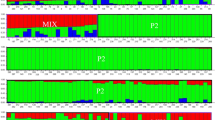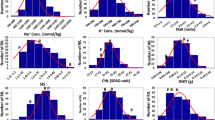Abstract
A set of 84 diverse rice genotypes were assessed for seedling stage salt tolerance and their genetic diversity using 41 polymorphic SSR markers comprising of 19 Saltol QTL linked and 22 random markers. Phenotypic screening under hydroponics identified three indica landraces (Badami, Shah Pasand and Pechi Badam), two Oryza rufipogon accessions (NKSWR2 and NKSWR17) and one each of Basmati rice (Seond Basmati) and japonica cultivars (Tompha Khau) as salt tolerant, having similar tolerance as of Pokkali and FL478. Among the salt tolerant genotypes, biomass showed positive correlation with shoot fresh weight and negative association with root and shoot Na+ content. The results indicated repression of Na+ loading within the tolerant plants. Linkage disequilibrium (LD) of the Saltol linked markers was weak, suggestive of high fragmentation of Pokkali haplotype, a result of evolutionary active recombination events. Poor haplotype structure of the Saltol region, may reduce its usefulness in marker assisted breeding programmes, if the target foreground markers chosen are wide apart. LD mapping identified eight robust marker-trait associations (QTLs), of which RM10927 was found linked to root and shoot Na+ content and RM10871 with shoot Na+/K+ ratio. RM271 on chromosome 10, an extra Saltol marker, was found associated to root Na+/K+ ratio. This marker showed a distinct allele among O. rufipogon accessions. There were also other novel loci detected on chromosomes 2, 5 and 10 influencing salt tolerance in the tested germplasm. Although Saltol remained as the key locus, the role of other genomic regions cannot be neglected in tailoring seedling stage salt tolerance in rice.


Similar content being viewed by others
Abbreviations
- SSR:
-
Microsatellite
- LD:
-
Linkage disequilibrium
- QTL:
-
Quantitative trait locus
- MST:
-
Mean salt tolerance score
- PIC:
-
Polymorphism information content
- PCA:
-
Principal component analysis
- MLM:
-
Mixed linear model
References
Alam R, Rahman MS, Seraj ZI, Thomson MJ, Ismail AM, Tumimbang-Raiz E, Gregorio GB (2011) Investigation of seedling-stage salinity tolerance QTLs using backcross lines derived from Oryza sativa L. Pokkali. Plant Breed 130:430–437
Aliyu A, Adamu AK, Muazu S, Alonge SO, Gregario GB (2011) Tagging and validation of SSR markers to salinity tolerance QTLs in rice (Oryza spp). In: International conference on biology, environment and chemistry, IPCBEE, vol 1, pp 328–332
Babu NN, Vinod KK, Krishnan SG, Bhowmick PK, Vanaja T et al (2014) Marker based haplotype diversity of Saltol QTL in relation to seedling stage salinity tolerance in selected genotypes of rice. Ind J Genet 74:16–25
Basavaraj SH, Singh VK, Singh A, Singh A, Singh A et al (2010) Marker-assisted improvement of bacterial blight resistance in parental lines of Pusa RH10, a superfine grain aromatic rice hybrid. Mol Breed 26:293–305
Bimpong IK, Manneh B, Sock M, Diaw F, Amoah NKA et al (2016) Improving salt tolerance of lowland rice cultivar ‘Rassi’ through marker-aided backcross breeding in West Africa. Plant Sci 242:288–299
Blumwald E, Grover A (2006) Salt tolerance. In: Halford NG (ed) Plant biotechnology: current and future uses of genetically modified crops. Wiley, UK, pp 206–224
Bonilla P, Dvorak J, Mackill DJ, Deal K, Gregorio GB (2002) RFLP and SSLP mapping of salinity tolerance genes in chromosome 1 of rice (Oryza sativa L.) using recombinant inbred lines. Philipp Agric Sci 85:68–76
Bradbury PJ, Zhang Z, Kroon DE, Casstevens RM, Ramdoss Y, Buckler ES (2007) TASSEL: software for association mapping of complex traits in diverse samples. Bioinformatics 23:2633–2635
Chattopadhyay K, Nath D, Mohanta RL, Bhattacharyya S, Marndi BC et al (2014) Diversity and validation of microsatellite markers in Saltol-QTL region in contrasting rice genotypes for salt tolerance at the early vegetative stage. Aus J Crop Sci 8:356–362
Cheng L, Wang Y, Meng L, Hu X, Cui Y et al (2012) Identification of salt-tolerant QTLs with strong genetic background effect using two sets of reciprocal introgression lines in rice. Genome 55:45–55
Chinnusamy V, Jagendorf A, Zhu JK (2005) Understanding and improving salt tolerance in plants. Crop Sci 45:437–448
Doyle JJ, Doyle JL (1990) A rapid total DNA preparation procedure for fresh plant tissue. Focus 12:13–15
Durbin J, Watson GS (1951) Testing for serial correlation in least squares regression II. Biometrika 38:159–179
Endelman JB, Jannink J-L (2012) Shrinkage estimation of the realized relationship matrix. Genes Genomes Genet 2:1405–1413
Gale J, Zeroni M (1984) Cultivation of plants in brackish water in controlled-environment agriculture. In: Staples RC (ed) Salinity tolerance in plants. Wiley, New York, pp 363–380
Gilmour SG (1996) The interpretation of Mallows’s C p -statistic. J R Stat Soc D 45:49–56
Gregorio GB, Senadhira D, Mendoza RD (1997) Screening rice for salinity tolerance. IRRI discussion paper series No 22. International Rice Research Institute, Manila
Gregorio GB, Islam MR, Vergara GV, Thirumeni S (2013) Recent advances in rice science to design salinity and other abiotic stress tolerant rice varieties. SABRAO J 45:31–41
Grieve CM, Grattan SR, Maas EV (2012) Plant salt tolerance. In: Wallender WW, Tanji KK (eds) Agricultural Salinity Assessment and Management, 2nd edn. American Society of Civil Engineers, Reston, Virginia, pp 405–459
Huyen L, Cuc L, Ismail A, Ham L (2012) Introgression the salinity tolerance QTLs Saltol into AS996, the elite rice variety of Vietnam. Am J Plant Sci 3:981–987
Islam MR, Gregorio GB, Salam MA, Collard BCY, Singh RK, Hassan L (2012) Validation of Saltol linked markers and haplotype diversity on chromosome 1 of rice. Mol Plant Breed 3:103–114
Kang HM, Zaitlen NA, Wade CM, Kirby A, Heckerman D, Daly MJ, Eskin E (2008) Efficient control of population structure in model organism association mapping. Genetics 178:1709–1723
Khatun S, Flowers TJ (1995) Effects of salinity on seed set in rice. Plant Cell Environ 18:61–67
Kulinskaya E, Lewin A (2009) Testing for linkage and Hardy–Weinberg disequilibrium. Ann Hum Genet 73:253–262
Lan T, Zhang S, Liu T, Wang B, Guan H et al (2015) Fine mapping and candidate identification of SST, a gene controlling seedling salt tolerance in rice (Oryza sativa L.). Euphytica 205:269–274
Lin HX, Zhu MZ, Yano M, Gao JP, Liang ZW et al (2004) QTLs for Na+ and K+ uptake of the shoots and roots controlling rice salt tolerance. Theor Appl Genet 108:253–260
Linh LH, Linh TH, Xuan TD, Ham LH, Ismail AM, Khanh TD (2012) Molecular breeding to improve salt tolerance of rice (Oryza sativa L.) in the Red River Delta of Vietnam. Int J Plant Genomics. doi:10.1155/2012/949038
Liu R, Zheng X-M, Zhou L, Zhou H-F, Ge S (2015) Population genetic structure of Oryza rufipogon and Oryza nivara: implications for the origin of O. nivara. Mol Ecol 24:5211–5228
Mallows CL (1973) Some comments on C p . Technometrics 15:661–675
Misra AN, Sahu SM, Meera I, Mohapatra P, Das N, Misra M (1997) Root growth of a salt susceptible and a salt resistant rice (Oryza sativa L.) during seedling establishment under NaCl salinity. J Agron Crop Sci 178:9–14
Mohammadi-Nejad G, Arzani A, Rezai AM, Singh RK, Gregorio GB (2008) Assessment of rice genotypes forsalt tolerance using microsatellite markers associated with the Saltol QTL. Afr J Biotechnol 7:730–736
Munns R (2002) Comparative physiology of salt and water stress. Plant Cell Environ 25:239–250
Munns R, James RA, Läuchli A (2006) Approaches to increasing the salt tolerance of wheat and other cereals. J Exp Bot 57:1025–1043
Perrier X, Flori A, Bonnot F (2003) Data analysis methods. In: Hamon P (ed) Genetic diversity of cultivated tropical plants. Science Publishers, Montpellier, pp 43–76
Price AL, Patterson NJ, Plenge RM, Weinblatt ME, Shadick NA, Reich D (2006) Principal components analysis corrects for stratification in genome-wide association studies. Nature Genet 38:904–909
Pritchard JK, Rosenberg NA (1999) Use of unlinked genetic markers to detect population stratification in association studies. Am J Hum Genet 65:220–228
Pritchard JK, Stephens M, Rosenberg NA, Donnelly P (2000a) Association mapping in structured populations. Am J Hum Genet 67:170–181
Pritchard JK, Stephens M, Donnelly P (2000b) Inference of population structure using multilocus genotype data. Genetics 155:945–959
Pritchard JK, Wen X, Falush D (2010) Documentation for structure software: version 2.3 University of Chicago. http://pritchardlab.stanford.edu/structure_software/release_versions/v2.3.4/structure_doc.pdf
Rahman MS, Das KC, Dipok KD, Kuntal BM, Badrul HC et al (2010) Breeding and anther derived lines of rice (Oryza sativa L.) for saline coastal areas of Bangladesh. Bangladesh J Bot 39:71–78
Ren ZH, Gao JP, Li LG, Cai XL, Huang W et al (2005) A rice quantitative trait locus for salt tolerance encodes a sodium transporter. Nat Genet 37:1141–1146
Searle SR (1987) Linear models for unbalanced data. Wiley, New York
Singh R, Singh Y, Xalaxo S, Verulkar S, Yadav N et al (2016) From QTL to variety-harnessing the benefits of QTLs for drought, flood and salt tolerance in mega rice varieties of India through a multi-institutional network. Plant Sci 242:278–287
Soda N, Kushwaha HR, Soni P, Singla-Pareek SL, Pareek A (2013) A suite of new genes defining salinity stress tolerance in seedlings of contrasting rice genotypes. Funct Integr Genomics 13:351–365
Thomson MJ, Ocampo M, Egdane J, Rahman MA, Sajise AG et al (2010) Characterizing the Saltol quantitative trait locus for salinity tolerance in rice. Rice 3:148–160
Tian L, Tan L, Liu F, Cai H, Sun C (2011) Identification of quantitative trait loci associated with salt tolerance at seedling stage from Oryza rufipogon. J Genet Genom 38:593–601
Umali DL (1993) Irrigation-induced salinity—a growing problem for development and the environment, World Bank technical paper number 215. The World Bank, Washington
Vinod KK, Krishnan SG, Babu NN, Nagarajan M, Singh AK (2013) Improving salt tolerance in rice: looking beyond the conventional. In: Ahmad P, Azooz MM, Prasad MNV (eds) Salt stress in plants: signalling, omics and adaptations. Springer, New York, pp 219–260
Vu HTT, Le DD, Ismail AM, Le HH (2012) Marker-assisted backcrossing (MABC) for improved salinity tolerance in rice (Oryza sativa L.) to cope with climate change in Vietnam. Aust J Crop Sci 6:1649–1654
Walia H, Wilson C, Condamine P, Liu X, Ismail AM et al (2005) Comparative transcriptional profiling of two contrasting rice genotypes under salinity stress during the vegetative growth stage. Plant Physiol 139:822–835
Wang Q, Tian F, Pan Y, Buckler ES, Zhang Z (2014) A SUPER powerful method for genome wide association study. PLoS ONE 9:e107684. doi:10.1371/journal.pone.0107684
Yoshida S, Forno DA, Cock JH, Gomez KA (1976) Laboratory manual for physiological studies of rice, 3rd edn. International Rice Research Institute, Manila
Yu JM, Pressoir G, Briggs WH, Bi IV, Yamasaki M et al (2006) A unified mixed model method for association mapping that accounts for multiple levels of relatedness. Nat Genet 38:203–208
Zapata C (2000) The D′ measure of overall gametic disequilibrium between pairs of multiallelic loci. Evol Int J Org Evol 54:1809–1812
Zhang Z, Ersoz E, Lai C-Q, Todhunter RJ, Tiwari HK et al (2010) Mixed linear model approach adapted for genome-wide association studies. Nat Genet 42:355–360
Acknowledgements
NNB acknowledges Department of Science and Technology, Government of India (GoI) for awarding the DST-INSPIRE Fellowship for his doctoral programme at the ICAR-Indian Agricultural Research Institute, New Delhi of which this study formed a part. The experiments conducted in this study were carried with the financial support to AKS under the accelerated crop improvement programme on development of abiotic stress tolerant rice (BT/PR11694/AGR/02/642/2008) from Department of Biotechnology, GoI.
Author information
Authors and Affiliations
Corresponding author
Ethics declarations
Conflict of interest
The authors declare that they have no conflict of interest.
Electronic supplementary material
Below is the link to the electronic supplementary material.
Rights and permissions
About this article
Cite this article
Babu, N.N., Vinod, K.K., Krishnamurthy, S.L. et al. Microsatellite based linkage disequilibrium analyses reveal Saltol haplotype fragmentation and identify novel QTLs for seedling stage salinity tolerance in rice (Oryza sativa L.). J. Plant Biochem. Biotechnol. 26, 310–320 (2017). https://doi.org/10.1007/s13562-016-0393-3
Received:
Accepted:
Published:
Issue Date:
DOI: https://doi.org/10.1007/s13562-016-0393-3




